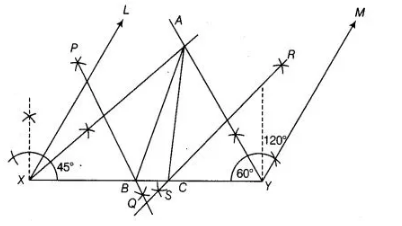A triangle if its perimeter is 10.4 cm and two angles are 45° and 120°.
Let ABC be a triangle. Then, given perimeter = 10.4 cm i.e., AB+ BC + CA = 10.4 cm and two angles are 45° and 120°.
say ∠B = 45° and ∠C = 120°
Now, to construct the ΔABC use the following steps.
1. Draw a line segment say $X Y$ and equal to perimeter i.e., $A B+B C+C A=10.4 \mathrm{~cm}$

2. Make angle $\angle L X Y=\angle B=45^{\circ}$ and $\angle M Y X=\angle C=120^{\circ}$.
3. Bisect $\angle L X Y$ and $\angle M Y X$ and let these bisectors intersect at a point $A$ (say).
4. Draw perpendicular bisectors $P Q$ and $R S$ of $A X$ and $A Y$, respectively.
5. Let $P Q$ intersect $X Y$ at $B$ and $R S$ intersect $X Y$ at $C$. Join $A B$ and $A C$. Thus, $\triangle A B C$ is the required triangle.
Justification
Since, B lies on the perpendicular bisector PQ of AX.
Thus, AB+ BC + CA = XB+ BC + CY=XY
Again, ∠BAX = ∠AXB [∴ in ΔAXB, AB = XB] …(i)
Also, ∠ABC = ∠BAX + ∠AXB [ ∠ABC is an exterior angle of ΔAXB]
= ∠AXB + ∠AXB [from Eq. (i)]
= 2 ∠AXB= ∠LXY [ AX is a bisector of ∠LXB]
Also, ∠CAY = ∠AYC [∴ in A AYC, AC = CY]
∠ACB=∠CAY + ∠AYC [ ∠ACB is an exterior angle of ΔAYC]
= ∠CAY + ∠CAY
= 2 ∠CAY= ∠MYX [∴ AY is a bisector of ∠MYX]
Thus, our construction is justified.
